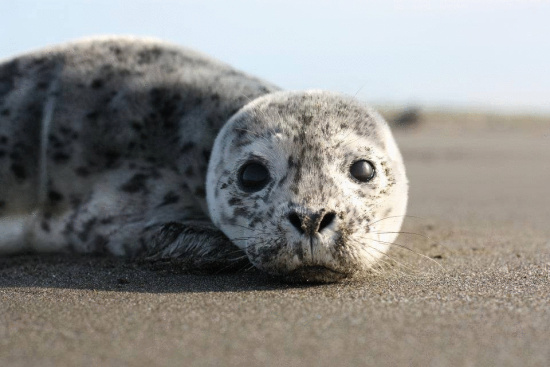Not necessarily in trouble. By Northcoast Marine Mammal Center.
Leave that seal pup alone! Our friends at the Northcoast Marine Mammal Center reminded us we’re in the midst of pup season, which means mama harbor seals often leave their pups on the beach while they forage, sometimes for hours at a time. “If you see one of these cuties,” NMMC says, “DO NOT touch it and keep your distance. Mom is probably not far away but will not come back if you are near them.”
It’s understandable folks would feel extra cautious, of course, given that hundreds of stranded, starving and sickly sea lion pups have been showing up on California beaches.
If in doubt, call the NMMC’s stranding coordinator at (707) 951-4722. Someone will come out to assess the animal and put it on watch.
(Unsure of the difference between seals and sea lions? Here!)
Wind may blow salmon and halibut opener hopes
Today kicks off what is expected to be a fine ocean sport fishing season for salmon and halibut. We turn to Kenny Priest and his ever-dependable “Fishing the North Coast” column for the scoop on conditions:
Friday marks day one of our sport ocean season on the North Coast as both salmon and halibut seasons will commence, bringing with it tons of excitement and loads of optimism. Anglers will take to the ocean — weather and conditions permitting — with hopes of another year of fantastic fishing. However, ocean conditions for Friday are looking a little on the blistery side. North winds have been howling all week and are forecasted to continue through the weekend. If the wind miraculously lies down, it will be game on. If not, expect to see some long faces hanging around the docks.
Return of the blob
Remember the warm blob? Jefferson Public Radio featured Humboldt surfer Bill Lydgate, HSU prof Eric Bjorkstedt, Humboldt’s Reel Steel charter captain Tim Klassen and Santa Cruz-based NOAA climate expert Nate Mantua discussing the blob and its effects. Listen here.
More bigger protection
On the good news front, last month Cordell Bank and Gulf of the Farallones national marine sanctuaries were expanded to protect more of the “Blue Serengeti” off the California Coast. The sanctuaries are destination feeding areas for endangered blue and humpback whales, sharks, salmon and seabirds that travel tens of thousands of miles.
The sanctuaries complement the network of marine protected areas along California’s coastline. Scientists are in the thick of studying the North Coast MPAs as part of an overall baseline monitoring project, well-documented in the current Humboldt magazine.
Washington oysters get toxed
Finally, a glance at the Outpost‘s Elsewhere feature led to a startled read on how some Washington oyster farmers plan to spray their oyster beds with imidacloprid, a neurotoxic pesticide, starting May 17. The article reports Margaret Pilaro Barrette, executive director of the Pacific Coast Shellfish Growers Association, as saying the use of pesticides in oyster cultivation on the West Coast and Alaska is confined to Willapa Bay and Grays Harbor.
Humboldt needs not be alarmed – or rather, one may be alarmed on behalf of Washington oyster eaters and the planet as a whole, but as far as the problems prompting the new pesticide use in Willapa Bay and Grays Harbor, those are not ones we have here. So continue to slurp down your Humboldt-grown oysters with pride and pleasure. (YWIO particularly enjoys “Buck a Shuck” Tuesdays, 6 to 8 p.m., at the Humboldt Bay Tourism Center.)
Jennifer Savage serves as the Northcoast Environmental Center’s Coastal Programs Director and chairs the Surfrider Foundation’s Humboldt Chapter.

CLICK TO MANAGE